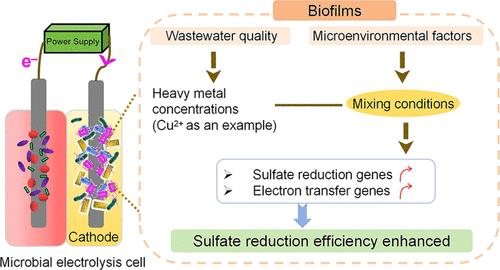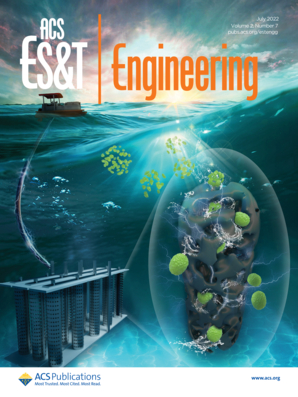Enhancing Sulfate Reduction Efficiency in Microbial Electrolysis Cells: The Impact of Mixing Conditions and Heavy-Metal Concentrations on Functional Genes, Cell Activity, and Community Structure in Sulfate-Laden Wastewater Treatment
IF 7.4
Q1 ENGINEERING, ENVIRONMENTAL
引用次数: 0
Abstract
Microbial electrolysis cells (MECs) are promising for the treatment of sulfate-laden wastewater. The performance of the MEC cathode biofilms is influenced not only by the wastewater quality but also by the hydrodynamic mixing condition. Yet, the combined effects of these combined conditions have seldom been explored. This study examines the effectiveness and operational patterns of MECs in treating sulfate-laden wastewater under varying heavy-metal (Cu2+ as representative) concentrations (0–80 mg L–1) and different hydrodynamic conditions (complete-mixing (CM) and nonmixing (NM, as control)). Results showed that CM-MECs achieved higher sulfate reduction efficiency (51 to 76%) compared to NM-MECs (with 46–69% of sulfate reduction) across the range of Cu2+ concentrations. Kinetic analysis revealed that CM-MECs reduced sulfate faster due to increased expression of genes involved in sulfate reduction and electron transport. Furthermore, CM-MECs maintained intact cell structures, enhanced electron transfer, and increased the relative abundance of Desulfobulbus when treating wastewater with low Cu2+ concentrations (<40 mg L–1). Microbial defense mechanisms against Cu2+ also contributed to the enhanced sulfate reduction efficiency in the CM-MECs. These findings offer new insights into the design MECs with flowing conditions and pave the way for their future application in the treatment of heavy metal and sulfate-laden wastewater.

提高微生物电解池的硫酸盐还原效率:混合条件和重金属浓度对含硫酸盐废水处理中功能基因、细胞活性和群落结构的影响
微生物电解池(MEC)在处理含硫酸盐废水方面前景广阔。微生物电解槽阴极生物膜的性能不仅受废水水质的影响,还受水力混合条件的影响。然而,人们很少探讨这些综合条件的共同影响。本研究考察了 MECs 在不同重金属(以 Cu2+ 为代表)浓度(0-80 mg L-1)和不同水动力条件(完全混合(CM)和非混合(NM,作为对照))下处理含硫酸盐废水的效果和运行模式。结果表明,在 Cu2+ 浓度范围内,CM-MECs 的硫酸盐还原效率(51%-76%)高于 NM-MECs(46%-69%)。动力学分析表明,由于参与硫酸盐还原和电子传递的基因表达量增加,CM-MECs 还原硫酸盐的速度更快。此外,在处理低浓度 Cu2+ 废水(40 mg L-1)时,CM-MECs 保持了完整的细胞结构,增强了电子传递,并提高了 Desulfobulbus 的相对丰度。微生物对 Cu2+ 的防御机制也有助于提高 CM-MECs 的硫酸盐还原效率。这些发现为设计具有流动条件的 MECs 提供了新的见解,并为它们将来在处理重金属和含硫酸盐废水中的应用铺平了道路。
本文章由计算机程序翻译,如有差异,请以英文原文为准。
求助全文
约1分钟内获得全文
求助全文
来源期刊

ACS ES&T engineering
ENGINEERING, ENVIRONMENTAL-
CiteScore
8.50
自引率
0.00%
发文量
0
期刊介绍:
ACS ES&T Engineering publishes impactful research and review articles across all realms of environmental technology and engineering, employing a rigorous peer-review process. As a specialized journal, it aims to provide an international platform for research and innovation, inviting contributions on materials technologies, processes, data analytics, and engineering systems that can effectively manage, protect, and remediate air, water, and soil quality, as well as treat wastes and recover resources.
The journal encourages research that supports informed decision-making within complex engineered systems and is grounded in mechanistic science and analytics, describing intricate environmental engineering systems. It considers papers presenting novel advancements, spanning from laboratory discovery to field-based application. However, case or demonstration studies lacking significant scientific advancements and technological innovations are not within its scope.
Contributions containing experimental and/or theoretical methods, rooted in engineering principles and integrated with knowledge from other disciplines, are welcomed.
 求助内容:
求助内容: 应助结果提醒方式:
应助结果提醒方式:


